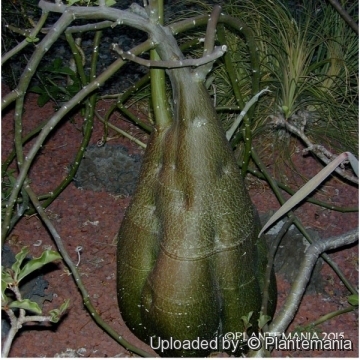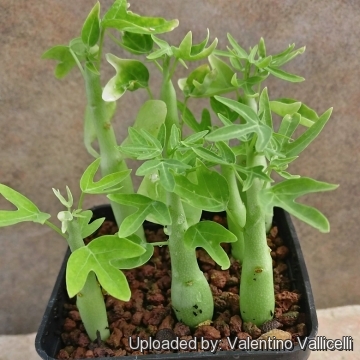
Adenia venenata Photo by: © Plantemania
A large specimen grown in the Reunion island.
Origin and Habitat: North Nigeria, Tanzania, Uganda and across sub-Sahara Africa to the Horn of Africa and East Africa (Djibouti, Eritrea, Ethiopia and Somalia). Yemen.
Altitude range: 0–1500(-1700) metres above sea level.
Habitat and ecology: Adenia venenataSN|34828]]SN|34828]] is a fairly common climber that grows in the savanna, in deciduous bushland or -woodland and in open stony scrub on a variety of soils; sand, clay, volcanic basalt or limestone. In Africa it is sometimes found planted near villages, because of its medicinal properties.
Synonyms:
Description: Adenia venenataSN|34828]]SN|34828]] is a semi-succulent, almost tree-like creeper or climber plant 1-8 m high. It produces a bottle-shaped swollen lower trunk with few to many glabrous glaucous twining branches arising from its top which ascends high into trees. It is one of the most remarkable pachypodous species in the genus.
Stem: Base of main stem fleshy, somewhat elongated conical to cylindrically thickened to about 2m high and 60 cm across, with smooth greenish bark. Branches with grey-green, rope-like smooth bark. Twigs thin, pendent. Tendrils simple, up to 12 cm long.
Leaves: Deciduous. Shallowly to deeply 3-5(-7)-lobed, base cordate, apex rounded, almost circular to ovate in outline, 1.5-12 cm long 1.5- 13 cm wide, grey to glaucous beneath, not punctate, 5-nerved from base. Petiole 1–8 cm long. Gland at blade-base single; glands on blade often present. Stipules narrowly triangular, 0.5–1 mm., withering.
Flowers: Cream or yellowish- green (-reddish?), in shortly (-1.5 cm long) stalked cymes, rarely in the axils of normal leaves, usually without tendrils. (1–)3–5-flowered in male plants, 1(–3)-flowered in female plants. Male flowers 30-56 mm long tubiform to fulleform. Hypanthium tubular, narrow, 9–15 mm long; calyx-lobes lanceolate, obtuse, 5–9 mm long. Petals oblong-lanceolate, 3–6 mm long, serrulate towards apex. Corona absent. Female flowers fulleform 15-24 mm long (including stipe) . Pistil 9–11 mm including 2.5–5 mm long gynophore. Styles largely united; stigmas woolly-papillate
Fruit (capsule): 1–2 per inflorescence, ovoid-ellipsoid, with more or less acute apex, 2-4.5 cm long, 1.5-3 cm wide, leathery, conspicuously veined.
Seeds: 15–35 per capsule, orbicular to broadly ovate narrowed at the top 4.5–6 mm long, with more or less acute apex.
Notes: Adenia venenataSN|34828]]SN|34828]] Forssk., is the type species of Adenia, collected in Yemen, at Al Hadiyah [Hadle], on March 1763 by Pehr (Peter) Forsskal (1732-1763).
Bibliography: Major references and further lectures
1) Hermann Jacobsen “Abromeitiella to Euphorbia” Blandford Press, 1960
2) Gabriella Harriet Schmelzer “Medicinal Plants”, Volume 1, PROTA, 2008
3) Umberto Quattrocchi “CRC World Dictionary of Plant Names: Common Names, Scientific Names, Eponyms, Synonyms, and Etymology”, Volume 1, CRC Press, 17 November 1999
4) Burkill, H.M.. “The useful plants of west tropical Africa”, Vol 4, 1985
5) M. Thulin “Flora Somalia”, Vol 1, 1993 [updated by M. Thulin 2008]
6) W. J. J. O. de Wildem “Flora of Tropical East Africa”, page 1, 1975
7) Henk Beentje, Joy Adamson, Dhan Bhanderi “Kenya trees, shrubs, and lianas” National Museums of Kenya, 1994
8) Clive Innes “Complete Handbook of Cacti and Succulents” Van Nostrand Reinhold Company, 1 December 1981
9) Adenia venenata in: UnSitoDelCactus web: https://www.unsitodelcactus.it/?loc=news_dett&id=458&commenti=1
 Adenia venenata Photo by: © Plantemania
Adenia venenata Photo by: © Plantemania Adenia venenata Photo by: © Plantemania
Adenia venenata Photo by: © Plantemania Adenia venenata - 3 months old seedlings. Photo by: Valentino Vallicelli
Adenia venenata - 3 months old seedlings. Photo by: Valentino VallicelliSend a photo of this plant.The gallery now contains thousands of pictures, however it is possible to do even more. We are, of course, seeking photos of species not yet shown in the gallery but not only that, we are also looking for better pictures than those already present.
Read More... Cultivation and Propagation: Adenia venenataSN|34828]]SN|34828]] is quite easy to grow. In pot it does not grow as in nature but you can still appreciate the bottle shaped caudex. Grow it in a large pot with a well draining mix. Water during the vegetative period by letting it dry well between one watering and the other. It requires intense light but protect it from blasting summer sun. It can be grown as a Bonsai .
Hardiness: In winter keep it dry at temperatures above 5 degrees Celsius (even if it is resistant to short frosts).
Propagation: Seeds or herbaceous cuttings. Leave cutting surface to dry well, before planting
Warning: handle with care because it is a poisonous plant
Uses: The plant is widely cultivated near villages for its medicinal and tribal uses. Adenia venenataSN|34828]]SN|34828]] is used to treat intestinal worms. In Kenya Turkana people use the leaves to treat cattle suffering from mange. Fruit possibly edible.














